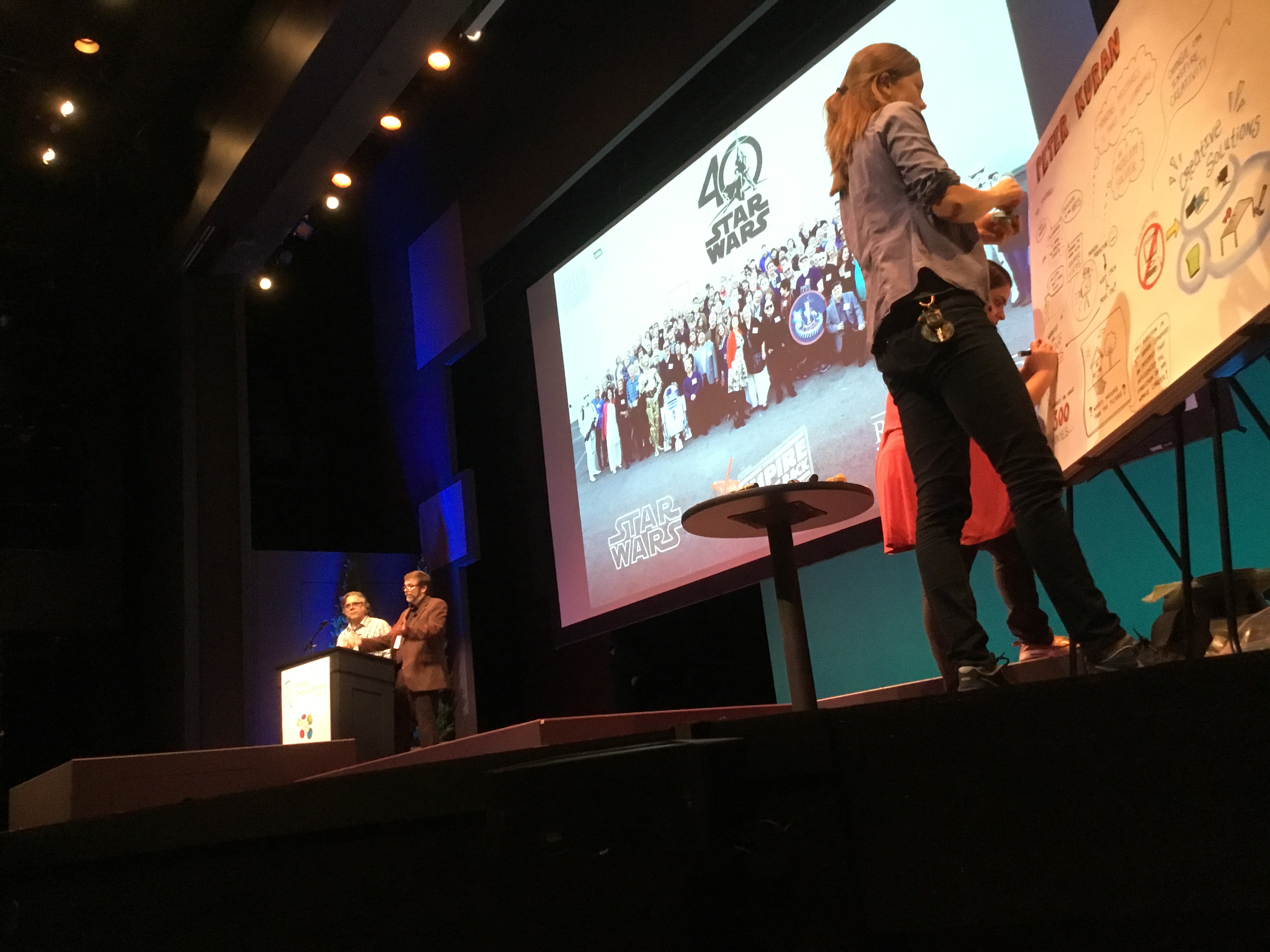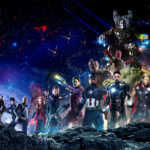Really, it did. The Creative Conference was incredible in Portland this year and if I’m not mistaken, it took a hiatus for several years, but I’m glad I could make this event even if it’s the last for a while. The speakers were awesome and the attendees were even cooler.
Creatives can sometimes be quiet and reserved while they let their work do the talking for them. They can be just as socially awkward as developers and that’s okay. Most geniuses are socially awkward and in that room, there was an overwhelming feeling of acceptance and safety.
These were some of my people.
Each presenter brought an incredibly relatable story full of the same challenges everyone else faces. The realization is that these people took great risks and chances to get where they are today. Being conservative about your abilities, is what’s holding you back. That felt like the theme of the event and I’m cool with that.
Unfortunately during a phone transition, I lost my pictures of the conference except fo the one below. The gals at the front were illustrating every talk on their own sheet of paper. When the talk was over they’d wrap up and stick them up on the wall for everyone to see. They were incredible!
I got to meet some really bright stars out there and I’m thankful for that.

Choosing a favorite presenter is tough. David Walkers cool and candid style, Lidia Yuknavitch session on “Waves” was a treat, Peter Kuran sharing Star Wars set stories and Angela’s experience of finding and chasing your dreams…there were only a few of the presenters. They were all great.
Below are my notes from the conference. Feel free to let me know if I missed anything. Bold items are ones I found particularly compelling.
Steve Gehlen, Chairman of the Conference
- Conference saved his life. Brought the conference back in 2008.
- Stay for all the presentations throughout the day.
- Take advantage of the networking opportunities.
- Scott Alley – Dark Horse comics.
David Walker, Comic Book Writer
- Reflections on Blackspotation
- Badassmofo Magazine
- Becoming Black
- Cofounder and least prepared speaker all day.
- Going over presentation last night and totally boring.
- Snuck in and made his own badge and was desperate to go.
- Shawn Levy, worked with and met originally. Shawn said you should write a book.
- Mathematics of what you can achieve in a day in number of words.
- In school, he was told to be a Fry Cook.
- Wanted to do comic books coming out of high school and barely graduated.
- Discovered that he did suck as an artist. Realized several years into school, that he was never going to be a comic book artist.
- Lived in the dorm and thought he was a film student. How come I never see you?
- Started writing, and thought that if you just write a lot, you would make it. Messed around with film for a long time. You have to change your perspective because everything takes time.
- Was so impatient creatively, that he found other things to do. Work on three things at the same time and locked on to something that worked.
- 5 years ran the film festival.
- Interviewed by Will Isner, and he said it was the best interview.
- He said “you’re too old? What?” You are never too old to get into it.
- “I write comics”.
- There’s more to it then put words in balloons. Comic books are written in scenes. Different space and time, are inside of panels and they suggest a shot.
- Comic Book is short. Graphic Novel, you need a bookmark.
- Comic Book writing looks like a script. They are letters to collaborators.
- Lots of words are changed into images and visuals. Only 35% of what you write will make it, many things will change.
- If you’re a director, you need to know a little bit about everything. Same thing with comics, you need to know a little bit of everything.
- Script, pencil, ink, color and then it changes.
- 5 Rules of Comics
- 1) Concept – the idea/story
- 2) Communication – writing out the story
- 3) Collaboration – working with others
- 4) Concession – adjusting to changes
- 5) Connection – finding your audience
- Collaborators are a part of everything.
- People control the market in ways that remove culture, differences, etc.
Lidia Yuknavitch, Best Selling Author
- Wave exercise.
- She doesn’t do the morning pages.
- She is not disciplined.
- Felt failure in the face of non-routine. Until the day she figured out that every mammal is a different kind of discipline.
- Process comes from self creation. Realized that process could be anything.
- Waves, we wait for them. They crash and come back at intervals. Her creative energy came in waves.
- Waves are kinetic energy underneath the water. Creative process is all underneath. Walk around with ideas for weeks or years. People fret about Waves.
- Everything I know about creative process, I learned why writing about creative process.
- The Chronology of Water
- It took 25 years for the whole story to come out. She was waiting for her wave. Didn’t know what it was, until the day she did.
- Dora, a head case. Someone who quit and never got over. It’s a case study of hysteria. Projected the story back as her story.
- Stories get projected on to them.
- “I am not the story you made of me.
- Your diagnosis doesn’t account for my creativity and fire.
- Taught me to not treat teens in the way society has commanded. We have a culture of acting out, and then call it misbehaving.
- She has done a TED talk.
- Death of her daughter and every book has a girl who lives. Death is also generative.
- You have to define who you are and saturate your whole world with that. Invent what’s inside you and you put it outside of you.
- The misfits manifesto. If you’re an OCD person, I love you.
- Nancy Drew books are amazing for kids.
- Creatives are misfits, a lot of us.
- Who are you in the world?
- 3rd and Washington Workshops for Caporia writing.
- They support the weirdness in their kid.
- Phases of writing. Laziness isn’t real and we project lazy on to homeless people when it’s the hardest life to live.
Wes Studi
- Has starred in over 60 movies and TV shows.
- Shouting out favorite actors Jason Overheels, Will Sampson. They were idols because they setup a registry for American Indians.
- It’s not easy to explain what you do, because you just do it. Explaining how you “create” is a horribly complex question.
- Got into the business late in life. Past experience in creating characters.
- Going back in time to deliver a performance for someone who lived 100’s of years ago. There’s no way to know how to portray someone whom is not documented like they are today.
- How do you act in a way where people feel like you’re actually in those situations.
- Having lived life and have felt similar emotions or feelings is part of what plays in acting. There is betrayal and remorse. Rollercoaster of emotions.
- At that time, pulling things in from experiences is what really got him to where he needed to be.
- Diving into feelings and creating scenes. When I get a script, I only read my parts and study them and those parts leading up to and after.
- My character doesn’t need to know what other characters are doing. Spontaneity is something that’s key to his creative process.
- Showed a clip from Planes.
- Roles aren’t always Native American.
- Fear feeds adrenaline.
- Hostiles coming in December.
Peter Kuran, Visual Effects Artist
- Lives in Vancouver, WA. Born and grew up in New Jersey.
- After school, wanted to go down to California and do special effects.
- Wanted to be part of the magic.
- Worked with Lucas on Star Wars a new Hope. Had to take pieces of film.
- There was one computer that operated some of these models. Got an interview.
- Took a 50lb projector with him and setup everything. Ran the film and at every splice the film broke.
- Let me work for a week, for free. If it doesn’t work out I’ll just leave and no pay. This is a great first job.
- Was working on SW at 19 years old. Would sleep on set so he didn’t have to waste time traveling.
- He wore the C3PO suit to test for the landspeeder. One of the workers took him out and showed him how to drive the landspeeder.
- He helped Anthony Daniels in and out of the suit.
- They kept him on projects and started doing freelance jobs.
- Has worked on 300 movies. Some of them were fun, some were great and some were terrible.
- Talking about adding shadows to the Empire Strikes Back.
- Worked on the Thing in 1982. Showed example that the title for the film was backlit by a light with a garbage bag. Took a match and lit the bag on fire to get the light behind.
- Ran the truck off the hill and on to a floor. They played the clip in reverse and launched the car by hitting underneath with a hammer.
- Lightsabers out in the dessert. The green washes out and it looks white instead. They wanted to have a bright green lightsaber. Used a green matte instead of a black matte. Won an award.
- Mark Hamill was in a car accident so in the beginning of Empire where Mark is beat up by the snow monster, he was ACTUALLY BEAT UP from a car accident. He had a rod through his nose that he played with and freaked out Peter (speaker).
Angela Medlin, Fashion Designer
- Designer for high-end global brands.
- Excited to speak with creatives.
- Amazing 25 year career.
- Rediscovering whole creative self.
- If you show people you have all these skills like: sing, design, apparel, illustrator then they think you aren’t focused and not really, an apparel designer.
- People in corporate environments hide their true selves, because they are afraid of being not taken seriously.
- She called out people and they did an exhibition that got 1500 people. North Force athletes were sharing their art. Everyone was really excited and passionate about this.
- Your talents and abilities should be with you all the time. Talk about it, be in your hand, etc.
- Everything she did, were inspired through her life.
- Published a book called Dreamer.
- House Dogge, Adidas, Nike, Jordan
- Got to a point where she’s not doing anything, she doesn’t want to do. Period.
- Create authentically, smash the boxes and own your journey. Be your whole creative self.
Marcelino Alvarez
- His job is to make sure other creative processes get done.
- Producers make lots of lists and look for patterns.
- It’s meta that part of a process is listing and that at the top is lists.
- Grabbing coffee used to be creating new opportunities. Meeting people, you don’t know who you might meet.
- If you don’t follow through, then there is no credibility.
- Build relationships.
- Leave your phone outside the bathroom and star at the droplets.
- Give yourself time to think.
- Social impact investing.
Kim Adams, Pixar Producer, VR Producer
- Consulting with two of the biggest technology companies in the word.
- Rollercoaster walk down Lombard street.
- 6th grade and through college she was acting.
- Worked at ILM in 1990. Amazing model shapes and amazing stages.
- Walking across the lot and snow was falling; they were filming an Old Spice commercial.
- Watched them produce Terminator 2.
- Don’t stay in one place too long. Don’t be worried about change. Challenge yourself.
- People she met on the jobs she did for free, is what started a lot of her opportunity.
- Worked on Office Space.
- Pearl Harbor work and being on a carrier.
- Master and Commander she worked on as well.
- Amittyville Horror, City of Ember, Apolocolypto – working with other creatures, like Mel Gibson. 7 months over schedule.
- She was determined and envisioned a future where she would be at Pixar. She would send notes and sent an email to someone 4 different times before they responded.
- Interviewed for 4 months, 47 people and 2-3 times.
- Became short with people, started having an attitude, at one of the best studios but it was just too much. You never have time to enjoy.
- 1 year of pre-production on Dory.
- Running time and composer of VR was inspiring.
- Master the Art of Networking, don’t be afraid. Never say never.
- Don’t be so focused on your route that you miss your destination.
- Bad ideas create good ideas.
- Fail as soon as possible.
- Be grateful.
Shawn Levy, Writer/Critic
- 20 year veteran of film reviews.
- Written two types of books which includes biographies and scenes.
- Moments when an entire culture expresses itself.
- The qualities of a scene and how Portland can be an incubator of expression.
- Technology and innovation brings changes to culture. This can also include demographic shifts.
- Getting a book done, means making lists and writing pieces of that list.
The Creative Conference really was a great experience. If you’re someone working in a creative industry you should do yourself a favor and check this one out in 2018 and beyond. Learn more about the conference and the people behind it here!
Have a question or want to share stories, feel free to leave a comment or connect with me on Twitter. Thanks for reading!



